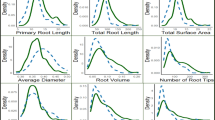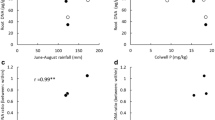Abstract
Lentil is a protein-rich pulse, grown mainly in developing countries as a rain-fed crop in nutrient-poor soils. Hence, the importance of root traits for efficient capture of soil nutrients and water can be crucial to its economical yield. Little is known about the lentil root system and even less about its relationship to grain yield. We compared the root system of two Bangladeshi lentil varieties, Barimasur-3 (BM-3) and Barimasur-4 (BM-4), in a pot experiment and related it to their multi-location grain yield in the fields. BM-4 maintained faster root development both at an early growth stage (20 days after sowing) and at flowering (60 days) compared to BM-3. The roots of BM-4 penetrated the 25 cm depth of the soil profile after 19 ± 1 days and while those of BM-3 took 24 ± 2 days to reach the same depth. The roots of BM-4 were covered with denser (26 ± 3 mm−1) and longer (0.48 ± 0.11) root hairs than BM-3 (density 17 ± 2 mm−1, length 0.32 ± 0.09 mm). The differential presence of root hairs increased the effective length of root system of BM-4 by 12 times and that of BM-3 by five times. The lentil varieties did not differ in their ability to induce pH change and acid phosphatase activity in rhizosphere. In the pot experiment, the uptake of macro-nutrients (K, P, Ca, and Mg) as well as micro-nutrients (Fe, Mn, Zn, Cu, B and Mo) by BM-4 was significantly higher, compared to BM-3. The varieties produced the same amount of shoot biomass. At five of six agro-ecological distinct field locations in Bangladesh, BM-4 gave significantly higher (10–20%) grain yield than BM-3. Linked with the higher grain yield, the benefit-cost ratio (BCR) of BM-4 was 3.14 and that of BM-3 were 2.62, indicating that BM-4 provided better return per unit investment, compared to BM-3, supported by the better root morphology and higher nutrient uptake. This may be one of the reasons supporting the popularity and preferred adoption of BM-4 among the Bangladeshi farmers, who grow lentil mainly on nutrient-poor soils. The results indicate the benefits of selection and breeding for superior root traits for better agro-economics.
Similar content being viewed by others
References
F Asmar T S Gahoonia N E Nielsen (1995) ArticleTitleBarley genotypes differ in extracellular phosphatase activity and depletion of organic phosphorus from rhizosphere Plant Soil 172 117–122 Occurrence Handle1:CAS:528:DyaK2MXmsVagtLg%3D
T R Bates J P Lynch (1996) ArticleTitleStimulation of root hair elongation in Arabidopsis thaliana by low phosphorus availability Plant Cell Environ. 19 529–538 Occurrence Handle1:CAS:528:DyaK28XktlGgt78%3D
T R Bates J P Lynch (2000) ArticleTitleThe efficiency of Arabidopsis thaliana (Brassicaceae) root hairs in phosphorus acquisition Am. J. Bot. 87 964–970 Occurrence Handle1:CAS:528:DC%2BD3cXlvVemsbs%3D Occurrence Handle10898773
F T Bingham (1982) Boron A L Page R H Miller Keeney (Eds) Methods of Soil Analysis Part 2 American Society of Agronomy Inc. Madison Wisconsin USA 431
D T Clarkson (1996) Root structure and sites of ion uptake Y Waisel A Eshel U Kafkaki (Eds) Plant Roots: The Hidden Half Marcel Dekker Inc. NewYork, Basel, Hongkong 483–510
B Dinkelaker H Marschner (1992) ArticleTitleIn vivo demonstration of acid phosphatase activity in the rhizosphere of soil grown plants Plant Soil 144 199–205 Occurrence Handle1:CAS:528:DyaK38XmtFWms7Y%3D
E C Doll R E Lucas (1973) Testing soil for potassium, calcium and magnesium L M Walsh J D Beaton (Eds) Soil Testing and Plant Analysis Soil Science Society of Am. Madison Wisconsin,USA 133–152
Erskine W and Saxena M C (Eds.) 1993 Lentil in South Asia. Proceedings of the Seminar on Lentils in South Asia, 11–15 March 1991, New Delhi, India. ICARDA, Aleppo, Syria. vi + 236 pp. ISBN 92-9127-003-2.
T S Gahoonia N E Nielsen (1992) ArticleTitleThe effect of root induced pH changes on the depletion of inorganic and organic phosphorus in the rhizosphere Plant Soil 143 185–189 Occurrence Handle1:CAS:528:DyaK38XltlSnsb0%3D
T S Gahoonia N E Nielsen (1997) ArticleTitleVariation in root hairs of barley cultivars doubled phosphorus uptake from soil Euphytica 98 177–182
T S Gahoonia N E Nielsen (1998) ArticleTitleDirect evidence on participation of root hairs in phosphorus (32P) uptake from soil Plant Soil 198 147–152 Occurrence Handle1:CAS:528:DyaK1cXivFGis7g%3D
T S Gahoonia N E Nielsen O B Lyshede (1999) ArticleTitlePhosphorus (P) acquisition of cereal cultivars in the field of three levels P fertilization Plant Soil 211 269–281 Occurrence Handle1:CAS:528:DyaK1MXntlKisb8%3D
T S Gahoonia N E Nielsen P A Joshi A Jahoor (2001) ArticleTitleA root hairless barley mutant for elucidating genetics of root hairs and phosphorus uptake Plant Soil 235 211–219 Occurrence Handle1:CAS:528:DC%2BD3MXotFahurg%3D
A Hamdi (1992) ArticleTitleHeritability and combining ability of root characters in lentil (Lens culinaris Madikus) Egyptian J. Agric. Res. 70 247–255
R M Hofer (1996) Root hairs Y Waisel A Eshel U Kafkai (Eds) Plant Roots: The Hidden Half Marcel Dekker Inc. New York, Basel, Hongkong 111–126
G Krasilinikoff T S Gahoonia N E Nielsen (2003) ArticleTitleVariation in phosphorus uptake of cowpea genotypes (Vigna unguiculata)due to differences in root and root hair length and root-induced rhizosphere processes Plant Soil 251 83–91
F Kurdali K Kalifo M Al Schamma (1997) ArticleTitleCultivar differences in nitrogen assimilation, partitioning and mobilization in rain-fed grown lentil Field Crop. Res. 54 235–243
W L Lindsay W A Norvell (1978) ArticleTitleDevelopment of DTPA soil test for zinc, iron, manganese, and copper Soil Sci. Soc. Am. J. 42 421–428 Occurrence Handle1:CAS:528:DyaE1cXltVKntLs%3D
H Marschner V Römheld (1983) ArticleTitleIn vivo measurements of root induced pH change at soil–root interface.Effect of plant species and nitrogen source Z. Pflanzenphysiol. 111 241–251 Occurrence Handle1:CAS:528:DyaL3sXlt1Whtbc%3D
H Marschner V Römheld (1996) Root included changes in the availability of micronutrients in the rhizosphere Y Waisel A Eshel U kafkaki (Eds) Plant Roots: The Hidden Half Marcel Dekker, Inc. New York, basel, Hong kong 557–580
SR Olsen CV Cole FS Watanabe LA Dean (1954) Estimation of Available Phosphorus in Soils by Extraction with Sodium Bicarbonate U S Print Office Washington DC 939
M Röhm D Werner (1987) ArticleTitleIsolation of root hairs from seedlings of Pisum sativum.Identification of root hair specific proteins by in situ labelling Physiol. Plant. 69 129–136
A Sarker J Kumar M M Rahman M S Hassan W Zaman M A Afzal A N M M Murshed (1999a) ArticleTitleRegistration of “Barimasur-3” Lentil Crop Sci. 39 1536
A Sarker W Erskine M S Hassan M A Afzal A N M M Murshed (1999) ArticleTitleRegistration of “Barimasur-4” Lentil Crop Sci. 39 876
Sarker A, Erskine W and Singh M 2003 Variation in shoot and root characteristics and their association with drought tolerance in lentil landraces. Genet. Resour. Crop Evol. (in press).
InstitutionalAuthorNameSAS Institute Inc. (1989) SAS/STAT. User Guide. Version 5 SAS Institute Inc. Cary,NC, USA
N H Shah F Y Hafeez M Arshad K A Malik (2000) ArticleTitleResponse of lentil to Rhizobium leguminosarum bv viciae strains at different levels of nitrogen and phosphorus Austr. J. Exp. Agri. 40 93–98 Occurrence Handle1:CAS:528:DC%2BD3cXjsVSiurc%3D
M A Tabatabai (1982) Sulfur A L Page R H Miller Keeney (Eds) Methods of Soil Analysis. Part 2. American Society of Agronomy Inc. Madison Wisconsin, USA 501
L Wang H Liao X Yan B Zhuang Y Dong (2004) ArticleTitleGenetic variability for root hair traits as related to phosphorus status in soybean Plant Soil 261 77–84 Occurrence Handle1:CAS:528:DC%2BD2cXlvVehtLY%3D
X Yan J P Lynch (1998) Genetic variation for root hair density and length in common bean in response to low phosphorus availability J P Lynch J Deikman (Eds) Phosphorus in Plant Biology: Regulatory Roles in Molecular, Cellular, organisms and Ecosystem Processes NumberInSeries19 American Society of Plant Physiologist Rockville, Maryland, USA
Yan X, Hong Liao H, Beebe S E, Matthew W, Blair M W and Lynch J P 2004 QTL mapping of root hair and acid exudation traits and their relationship to phosphorus uptake in common bean. Plant Soil (in press)
M Yusuf Ali L Krishnamurthy N P Saxena O P Rupela J Kumar C Johansen (2002) ArticleTitleScope for genetic manipulation of mineral acquisition in chickpea Plant and Soil 245 123–134
Author information
Authors and Affiliations
Corresponding author
Rights and permissions
About this article
Cite this article
Gahoonia, T.S., Ali, O., Sarker, A. et al. Root traits, nutrient uptake, multi-location grain yield and benefit–cost ratio of two lentil (Lens culinaris, Medikus.) varieties. Plant Soil 272, 153–161 (2005). https://doi.org/10.1007/s11104-004-4573-x
Received:
Accepted:
Issue Date:
DOI: https://doi.org/10.1007/s11104-004-4573-x




